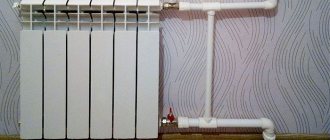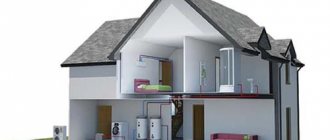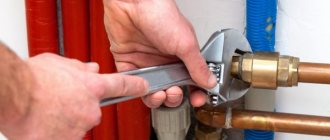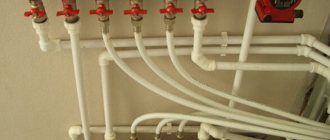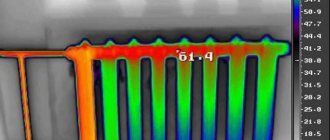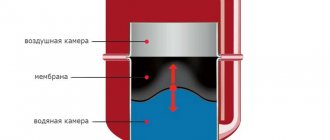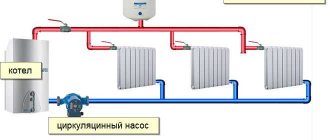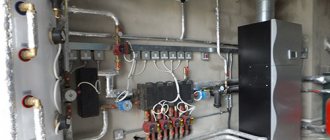If a country house is actively used not only during the summer season, but also during the cold season, the creation of a high-quality heating system in it is an urgent need.
Different coolants can be used in heat supply lines: air heated to 60°C, water steam at 130°C and water at a temperature of 95°C. Water heating is most often used.
One of the main advantages of this coolant is the ability to install various water heating systems depending on the design features of the house, personal preferences and other factors.
In the article, we described a detailed classification of water heat supply schemes, outlined the features of each option, and also provided recommendations for choosing the main components of the system. The information presented will help you design the heating of a private home.
Requirements for the operation of the heating system
With all the variety of water heating systems, there are a number of general requirements for their operation.
They have to:
- uniformly warm up all the air in the rooms;
- be repairable;
- do not create difficulties during operation;
- be linked to ventilation systems;
- be regulated.
The operating principle of the heating system itself is also common: water is heated, after which it circulates through the pipeline and releases the resulting heat, warming the rooms.
The coolant in winter can be a non-freezing liquid - antifreeze. So that the ethylene glycol contained in its composition does not cause corrosion of pipelines
Do-it-yourself water heating installation
Before deciding to install the system yourself, it is important to consider the following:
- Since the work on arranging water heating directly affects the entire house and its utilities, it is advisable to combine these activities with major repairs.
- If you plan to install the boiler on the floor, you will definitely need a separate room for its installation.
- The location for the boiler room is selected taking into account the requirements of current standards - it is well heated and has effective ventilation.
The generally accepted procedure for installing a heating system, as well as its connection to boiler equipment, takes into account many associated factors that require separate consideration.
Water heating systems
Despite all the external differences and different connection schemes, the basic operating principle of water heating systems is the same. The coolant heated in the boiler is transported through a pipeline to the heating devices.
As the water cools, it transfers heat to the environment and then returns to the place where it will be heated. This cycle repeats itself over and over again.
Natural and forced circulation
The following types of heating systems are used in private homes:
- with natural circulation;
- with forced circulation.
Natural circulation . Its performance is based on the difference in density between hot and cold. The upper positions of such a system are occupied by warm water, and the lower positions by cold water. When warm water cools down, it moves down, and when it warms up, it moves up.
The second factor that ensures the natural circulation of water masses is the slope at which the pipes are installed.
This is how the sources of circulation pressure are graphically represented. Firstly, its appearance is due to different water temperatures, and secondly, the inclined position of the pipes (+)
The advantage of the natural circulation scheme is its complete independence from the power supply.
It has many more disadvantages:
- small radius of action , not exceeding 30 m in the horizontal dimension;
- warm-up duration – a long period of reaching operating temperatures at all points of the system upon startup after a long break;
- risk of work stoppage due to ice formation in the open expansion tank.
The diameter of the pipeline must be large enough due to the low circulation pressure in the circuit. This factor also influences the choice of batteries, because modern radiators have a too narrow cross-section, which creates additional resistance that counteracts circulation by gravity.
In order to further stimulate the movement of the coolant, the pipeline is constructed with a slope so that there is an average of 3 mm per 1 linear meter. Correct installation of pipes at the right angle is not an easy task, but without solving it, the system will function much slower and more efficiently.
Due to the fact that the coolant sequentially moves through the devices to those closest to the battery supply line, it arrives at a higher temperature (+)
The coolant flows to the distant radiators of gravity systems when it has already cooled down significantly. To maintain the heating temperature, cast iron radiators should be used. To balance the temperature difference, the furthest batteries must have more sections than those closest to the boiler.
Forced circulation is provided by a pump. The circuit may contain one or several pumps. Using several pumps is preferable: an emergency shutdown of one of them will not damage the entire heating system.
The coolant moves cyclically along a closed circuit, which includes an expansion tank, which eliminates the evaporation of water.
A distinctive feature of a water heating system with forced circulation of coolant is the presence in the circuit of a pump, which promotes the movement of water
Advantages of a forced circulation system:
- for heating installation you will need more pipes, but of a smaller diameter;
- you can use different types of radiators and heat pipes with small diameters;
- the temperature of heating devices is easier to regulate;
- the range of action has been significantly expanded due to artificial stimulation of coolant movement;
- the possibility of using heating units with increased coolant characteristics.
The disadvantage of forced systems is their dependence on energy supply. In order to avoid incidents with complete heating inactivity, it is recommended to stock up on a diesel or gasoline generator.
In addition, the disadvantages include:
- the need to accurately calculate the diameter of the pipeline, because too narrow channels will sharply increase the hydraulic resistance, and when circulating through excessively wide pipes, the coolant will “noise”;
- the considerable cost of construction due to the almost double length of the pipeline, the inclusion of one or two circulation pumps in the circuit, and, if necessary, a booster pump;
- mandatory use of expensive regulators of coolant flow, its temperature and pressure in the system.
The correct choice of the type of circulation depends on the individual characteristics and location of the building in which the water heating will be installed. However, recently they have begun to resort to schemes with natural movement less and less, using them mainly in buildings for temporary residence.
Most often, private houses are equipped with systems with artificially forced coolant movement due to significantly greater capabilities.
Combined circulation systems
The combined system can operate in both natural and forced modes. This means that when installing it, it is necessary, as in the case of using natural circulation, to provide for a pipe slope of 3-5 mm per linear meter, as well as installing a pump, as for forced circulation.
Typically, such a heating scheme includes a solid fuel boiler.
The circuit includes: 1- electric boiler, 2- solid fuel boiler, 3- pump. This is a diagram of a combined heating system, in which, in addition to the pump, there is an inclined pipeline system, and the electric boiler is duplicated with a solid fuel one, so that the system can operate without electricity (+)
The point of using a combined system is that it will continue to operate even in the event of a power outage. But a sudden cessation of heating in winter threatens not only a decrease in the temperature in the room.
Elements of the heating system may simply fail because water, expanding when freezing, will break their tightness.
Laying heating networks[edit]
In cities and industrial enterprises serving tens and hundreds of buildings simultaneously, the installation of water heating networks is carried out according to an extensive dead-end scheme as the least expensive and metal-intensive.
Fig. 2.8.6. At the same time, they should provide for the reservation of heat to consumers through: the joint operation of several energy heat sources on a common heating network, the laying of backup heat pipelines, and most often through the installation of blocking jumpers between the heat mains of adjacent areas (Fig. 2.8.6).
Rice. 2.8.6. Diagram of a heating network with blocking jumpers and redundant pumping substations (heat source - thermal power plant with a capacity of 500 MW with an estimated heat consumption of 1800 MW, service radius 15 km)
When laying heating networks underground, sections of pipelines with a diameter of 300 mm or more are primarily subject to backup.
Depending on the climatic conditions of the regions in which heating networks are laid, the amount of heat supplied in the event of an accident and the use of reserve should not be lower than the data given in table. 2.36.
L14
Table 2.36. Minimum permissible amount of transferred heat [14]
| Minimum diameter of pipelines, mm | Estimated outside air temperature for heating design tНхБ5, °С, in the region | ||||
| — 10 | — 20 | — 30 | — 40 | — 50 | |
| Minimum permissible amount of heat during an accident in % of the calculated value | |||||
| 300 | No reserve required | No reserve required | No reserve required | No reserve required | 50 |
| 400 | ²-² | ²-² | ²-² | 50 | 60 |
| 500 | ²-² | ²-² | 50 | 60 | 70 |
| 600 | ²-² | 50 | 60 | 70 | 80 |
| 700 or more | 50 | 60 | 70 | 80 | 90 |
When laying heating networks above ground, 70% redundancy is provided in regions with design temperatures tнхБ5 below –40°С for pipelines with diameters of 1200 mm or more.
For buildings in which interruptions in the heat supply are not allowed, 100% backup heat supply from networks should be provided.
Shut-off valves must be installed at all outlets of water heating networks from the heat source and at the inputs and outputs to heating points. On pipelines of water heating networks with diameters of more than 100 mm, sectional valves are installed at distances of no more than 1000 m from each other. For pipelines with diameters of 400–500 mm, the distance between sectional valves can be increased to 1500 m, and for Dу > 600 mm – up to 3000 m.
Gate valves are also installed on branches Dу > 100 mm from the main, as well as in nodes on branches to individual buildings (regardless of the diameter of the branch).
For valves and gates on water heating networks Dу > 500 mm at ру > 1.6 MPa and Dу > 300 mm at ру > 2.5 MPa, and on steam networks Ду > 200 mm at ру > 1.6 MPa, bypass should be provided pipelines (unloading bypasses) with shut-off valves of at least 0.1×Dу of the main pipeline. At the entrance to heating points and at the exit from them, the installation of mud filters (filters) is mandatory. Mud collectors are also installed in front of heating network pumps and in front of regulators in hydraulic mode cutting units. At the highest points of heat pipelines of heating networks, including at each sectioned section, a fitting with shut-off valves for air release must be provided. At the lowest points of pipelines of water heating networks and each sectioned section, it is necessary to provide fittings (drains) with shut-off valves for draining water. The diameters of the drains must ensure emptying of a pipeline section with a diameter of 300 mm in 2 hours; 350–500 mm in 4 hours; more than 600 mm in 5 hours.
In populated areas, underground installation is provided for water heating networks, and for heating networks with diameters up to 400 mm, ductless installation is preferred, and heating pipelines of large diameters are laid in impassable channels or urban and intra-block tunnels.
In areas outside populated areas that are not subject to further development, ground installation on low supports should be provided.
Methods for installing water heating systems
Let's consider two main installation schemes for heating systems.
Single pipe heating system
The design of the pipeline in the single-pipe version is characterized by a direct sequence of supplying coolant to the radiators. The coolant fills and warms up the first battery, then the next, and so on.
Two pipes are connected from one pipe to each radiator: the first is needed to supply coolant, and the second is to drain partially cooled water.
A single-pipe heating system is characterized by a sequential connection of all radiators, in which the coolant, having passed through the first heating device, enters the next one.
The peculiarity of this scheme is the relatively low heating of the last battery compared to the first, since the water “reaches” it, having already given up part of its heat.
Another disadvantage of the single-pipe heating option is that it is impossible to stop the supply of coolant to one specific radiator in case it breaks down. You'll have to shut down the entire system.
Two-pipe system and its varieties
In a two-pipe heating scheme, as is already clear from the name, not one, but two pipes are involved. In this case, each of the batteries is connected by one pipe to the main line through which the coolant is supplied, and by the second to the return pipe. It turns out that separate pipes are provided for hot and cooled coolant.
This system involves two pipes: one carries hot water, entering the radiators through pipes, and the second carries coolant (+) from the batteries.
Thanks to this heating design, the water in all radiators has almost the same temperature. The operation of such a system is easier to control, adjust and automate.
The two-pipe system, in turn, is divided into two types:
- with the upper gasket of the supply pipe, i.e. with top wiring;
- with the bottom gasket of the supply pipeline, i.e. with bottom wiring.
Systems with overhead wiring are built mainly in multi-storey buildings with an attic space. Schemes with bottom routing are a priority in private low-rise construction, because they make it possible to hide the laying of the pipeline to the maximum and eliminate or reduce the number of risers.
A two-pipe heating system for a private house is often made according to a collector circuit, although the latter can also be single-pipe. The radial arrangement of pipeline sections allows to significantly reduce the cost of heating the coolant (+)
A comparative description of one-pipe and two-pipe heating systems is given in the video material, which is located at the bottom of our article.
The principle of operation of water heating of a private house
The essence of the operation of a heating system in which water is the coolant is to heat it in a heating device and move it to devices that transfer heat to the premises. Thermal energy can be transferred using radiators, convectors or by installing heated floors. Water heated to a certain temperature, moving through them, returns to the heater in a cooled state. In this device, the coolant is heated and the cycle repeats.
Until some time, the movement of the coolant occurred solely due to the laws of physics. When installing a modern heating system, pumps are used to circulate water. This technical solution led to an increase in the efficiency of the heating unit and increased the efficiency of its operation by reducing the volume of the heated coolant.
A two-story house has its own characteristics
Heat generators produced by modern manufacturers are high-tech units. They are characterized by high productivity and efficiency. The heating system complex includes pumps that ensure the movement of water, a tank necessary to discharge part of the heated liquid, and automation that monitors the safe operation and comfortable operation of the equipment.
Basic elements of the heating system
To heat the coolant, a boiler is used, the type of which determines the design features of the entire heating system in the house. Heating devices with natural draft must be installed in specially equipped rooms - boiler rooms, since their normal operation requires the creation of a chimney.
Boiler equipment equipped with forced draft can be installed where it is convenient.
The required air is supplied using coaxial inlets, which are equipped with electric fans. Boilers that provide not only floor installation, but also the possibility of mounting on a wall are very popular.
Installation of radiators or convectors involves placing them under the windows. This is due to the fact that it is in these places that heat leaks can occur. The heating element in some systems may be a warm floor.
Heating scheme for home
Having decided on the type and type of heating device and heat-removing devices, as well as the location of their installation, pipes are laid out. To create the required microclimate in the premises of the house and the efficient operation of the heating system, it is necessary to carefully plan and calculate all the nuances of the design and its elements for each room.
Open and closed heating systems
In addition to the types of water heating systems we have already discussed, there is a division into open and closed structures.
An open heating system consists of a boiler (any type except an electric one is used), pipelines, heating radiators and an expansion tank, into which excess water flows as it expands during the heating process.
The tank is not sealed, water from the system can evaporate, so its level must be monitored and topped up if necessary.
In order for an open heating system with overhead wiring and natural coolant circulation to work more efficiently in winter, it is recommended to insulate the supply riser. This measure will prevent the coolant from cooling and, as a result, slowing down its movement (+)
The pump is not used in an open heating system. The heating boiler is located at its lowest point, and the expansion tank is located at its highest point.
The closed design is airtight . It includes all the same elements as the open one. But since the movement of coolant in it is forced, the mandatory list of elements is supplemented by a circulation pump.
The expansion tank, which is part of a closed structure, consists of two rolled parts, separated by a diaphragm. When an excess of expanded liquid occurs in the system, it enters one of the chambers of the tank, pushing the diaphragm into the second chamber filled with nitrogen or air.
As the coolant expands, the pressure in the system increases, and the part of the tank filled with water tends to displace and compress the gas mixture. When the pressure limit in the tank is exceeded, a safety valve is activated, releasing excess coolant.
A closed heating system is characterized by forced movement of coolant and the presence of a closed expansion tank with a membrane; this system is more complex than an open one
Each heating system has its own advantages and disadvantages. They differ in a number of characteristics and are suitable for various objects. If you need to heat a small private house or cottage, use a simple and reliable open design.
A closed heating system, which is more complex to install and operate, is more often used in large cottages and multi-storey buildings.
Types of heating according to the method of pipe routing
Single-pipe
This heating system involves the installation of one pipe through which the coolant is supplied to the radiators and returns back to the boiler. Heating radiators are connected to this main line in series or in parallel, where heat exchange occurs.
The advantage of this scheme is its low cost. You will need a minimum number of pipes and various fittings.
But the system cannot be called effective and convenient, since it has several significant disadvantages:
- it is impossible to manually or using thermal valves regulate the volume of coolant entering each battery, so it will not be possible to set the desired temperature in each individual room;
- the amount of thermal energy transferred to the radiators will decrease as the radiators move away from the boiler, therefore, the farthest (lowest) rooms will be heated worse.
Scheme of a single-pipe heating system
You can get around some of the limitations of the described system by installing a bypass - a bypass pipe - connecting the inlet and outlet pipes of the radiator directly. In this case, by opening and closing the shut-off and control valves, you can not only set a comfortable battery temperature, but also (if necessary) dismantle and repair it without stopping the operation of the entire heating network.
Two-pipe vertical with bottom wiring
The main difference between a one-pipe wiring diagram and a two-pipe one is the presence of two pipelines: the first supplies hot coolant to the radiators, the second carries cooled water and delivers it back to the boiler.
Thanks to this scheme, it is possible to regulate the volume of liquid entering each battery and achieve the most comfortable temperature in the rooms.
Two-pipe heating system with bottom wiring
One of the options is a two-pipe system, with vertical risers and a lower location of supply pipes.
Its features are as follows:
- Along the lowest level of the system, pipelines connected to the heating device are laid from the heating boiler.
- From these mains, risers run upward, raising the coolant to the highest point of the system and delivering it to the heating radiators on each floor.
- Then, through another pipe, the cooled liquid is returned for a second heating cycle.
The disadvantage of this solution is the danger of airing the system.
It is necessary to provide devices for removing air from the pipes and radiator:
- an air pipe rising to the highest point of the system;
- open type expansion tank or membrane device with a special air valve;
- Mayevsky taps mounted at the top of each battery.
The Mayevsky crane will help avoid airing the heating system
Two-pipe vertical with top wiring
In this case, the distribution of liquid occurs at the highest point of the system - in the attic or under the ceiling of the upper floor. The coolant is delivered there by a vertical pipe, after which it flows through horizontal pipelines into the batteries.
An expansion tank is also needed here, but it is better to use a sealed one so that you can increase the water pressure rather than increase the heating efficiency.
Heating diagram with top wiring
Double-pipe horizontal
This type of liquid distribution through pipes is most common in the construction of private houses and cottages. The peculiarity here is that to ensure the flow of water, it is necessary to install a circulation pump, since it will not be possible to achieve the desired speed of water movement in a natural way.
Radiation diagram for heating pipes
Pipes are laid according to one of several schemes:
- Dead end . The advantage of this method is that it uses pipes quite economically. The downside is the significant length of the system, which makes its precise adjustment difficult.
- Along the way . In such a system, the length of the heating circuits is shorter, making them easier to adjust. However, the costs of purchasing pipes and installation work increase significantly.
- Collector . In this case, each radiator is connected using pipes to two combs - supply and outlet. The most efficient network, but its installation cost is higher than all others. In addition, it is necessary to provide for hidden pipe laying, since it will not be possible to lay such a quantity along the walls aesthetically.
Heating system elements
Since we are going to install water heating in the house with our own hands, we need to have an idea of the components of the proposed design.
Determining the right boiler
The boiler is the heart of the heating system. It is very important to choose it correctly, since the reliability of heat supply largely depends on it.
Heating boilers can be used either singly or in pairs, for example, in addition to an electric boiler, a solid fuel boiler can be included in the circuit in case of a power outage
Depending on the fuel used in the boiler, the following types of these devices are distinguished:
- Gas . This boiler is most popular among consumers. It is easy to install and works without unnecessary noise. Gas is relatively inexpensive and produces a lot of heat when burned. But to use it, you need to obtain permission, order the installation of a supply line and organize exhaust ventilation in the boiler room.
- Electrical . These boilers are the safest. Their installation location does not require any additional equipment. Their operation does not produce open flames or combustion products that could cause poisoning. But the efficiency of this device is relatively low, electricity is expensive, and the energy-intensive boiler requires a reliable power grid.
- Liquid fuel . Unlike gas boilers, these boilers are equipped with a special type of burner. This equipment requires a special boiler room. Liquid fuel quickly pollutes the boiler.
- Solid fuel . These devices burn coal briquettes and other types of solid fuel. If you are ready to prepare firewood or coal for the entire cold season, then you can use this option.
Combination boilers are considered the most reliable, in which different types of fuel can be used. There is only one drawback to such equipment - such boilers are expensive.
What are heating radiators?
In order not to be disappointed with the results of the work performed, you need to take a responsible approach to the choice of radiators. In this case, you should focus not so much on aesthetic qualities, but on the technical characteristics of the batteries. And the technical properties largely depend on the material used to make these products.
Modern cast iron radiators can look very attractive, especially if the interior of the room as a whole is designed in the same style.
Radiators are:
- Steel . These inexpensive products are too susceptible to corrosion. If the water is drained from the system in the summer when heating is not used, the service life of steel radiators can be significantly reduced.
- Aluminum . These attractive looking radiators heat up fairly quickly. Only significant pressure drops have a negative effect on them. In private homes this danger does not threaten them.
- Bimetallic . Such batteries are resistant to corrosion from aluminum, and high heat dissipation from steel.
- Cast iron . These products are expensive, but they will last a very long time. They take a long time to heat up, but they also take a long time to cool down. The significant weight of cast iron products is not a hindrance during their operation, but can slow down the installation process.
There are new models of radiators that have a protective coating applied to the inner surface. These batteries are a little more expensive, but the money spent on them is more than worth it.
Image gallery
Photo from
Cast iron radiators for heating systems
Aluminum devices for heating systems
Bimetallic devices
Budget steel version of devices
How not to make a mistake with pipes
Installing a heating system will require a lot of pipes.
Which one should you prefer:
- Metal . The service life of such pipes is not very long. Over time, metal products can rust. They are mounted using threaded connections.
- Polymer . This is an inexpensive but fairly reliable material that is resistant to corrosion. Even a non-professional can install these pipes. A pipeline made of polymer pipes will last a very long time.
- Metal-plastic . These pipes contain aluminum and plastic. The pipeline from them is assembled using threaded or press connections. As a byproduct of the high coefficient of thermal expansion of these pipes, they can crack if the water temperature changes suddenly.
If the home owners have no budget restrictions, it makes sense to install heating systems using copper pipes. This is a very expensive material, but the costs are worth it. Such pipes are reliable and durable.
They tolerate increases in temperature and pressure well. For their installation, soldering is used - silver-containing high-temperature solder.
Everything we told you above concerned the radiator water supply. But water can also be used as a coolant in other heating systems.
When installing a water heating system, you may need quite a lot of pipes, so you need to calculate the feasibility of purchasing expensive products and focus on your real capabilities
Read more about the characteristics and selection of heating pipes in this article.
Pipe selection
Copper pipes are the most expensive and reliable.
Separately, the issue of the types of pipes used in arranging a heating system in private homes is considered. Since each of the materials used has its pros and cons, it is advisable to understand which one is more preferable.
Metal (steel and copper) pipes
Installing water heating with steel pipes will not cost the owner too much, which is considered an indisputable advantage of the proposed choice. However, there is also a known disadvantage of this material, which is easily susceptible to corrosion. Another thing is copper analogues, which have many advantages, including resistance to the destructive effects of the environment and durability.
However, this attractive material also has one significant drawback - the high cost of copper pipes, which not every user will decide to purchase. Therefore, in the situation with metal highways, the final decision remains with the homeowner.
Polymer (polypropylene) pipe products
Plastic pipes do not corrode.
The main advantage of polypropylene pipes is their resistance to external influences, manifested in the form of corrosive and chemical destruction. In addition, they are valued for their lightness and ease of installation.
The use of pipe products of this class allows you to save on fuel consumption (it does not matter whether it is gas or electricity). This is explained by the low coefficient of friction against the walls, which makes it possible to increase the speed of circular movement of the coolant, as a result of which heat is dissipated exclusively in the batteries alone.
The advantages of polypropylene pipes also include the permissibility of use in heating systems of any type - closed or open.
Metal-plastic pipe blanks
Construction of a metal-plastic pipe
The advantages of metal-plastic pipes include all the advantages inherent in their polypropylene counterparts. In this case, the ability to “hold” very high temperatures and good flexibility (plasticity) are especially highlighted. The latter circumstance allows them to be used in “warm floor” systems.
A relative disadvantage of metal-plastic products is their high cost, which is noticeably higher than the same figure for polypropylene samples.
Water system "Warm floor"
“Warm floor” can either successfully complement radiator water heating or become the only source of heating for rooms if we are talking about a low-rise building. A huge advantage of the “Warm House” is that this system provides conditions that fully meet the sanitary and hygienic standards of the premises.
The air is heated unevenly along the height of the room: in the upper part of the rooms it is colder, and in the lower part it is warmer.
Warm floors are a wonderful invention that allows you to warm up a room in height in full compliance with the sanitary and hygienic standards required for it (+)
The system temperature is only 55°C, which meets design standards. The installation of heated floors is carried out over the entire area of each room. This is quite a complex job that can only be done efficiently at the stage of building a house. Operating the system also poses a number of difficulties.
Baseboard heating system
If installing a “Warm House” is difficult, and radiators spoil the interior of the room, you can use a baseboard heating system.
With this type of heating, the pipes are installed behind the baseboard, that is, slightly above the floor level. In this case, the room, as in the case of “Warm Floor,” warms up in the correct sequence.
Thanks to baseboard heating, there is no need to rack your brains over how to fit pipelines, manifolds and radiators into the interior of a country house so that they are not conspicuous (+)
At the same time, the floor is heated, which creates favorable conditions at any time of the year. Heating under the baseboard is becoming more and more popular and is gradually becoming fashionable.
Two-pipe heating circuit
The use of a two-pipe home heating system allows us to solve the problem of individual control of heating devices. This is achieved by connecting each of the radiators to both the supply and return. This design solution leads to greater consumption of materials. But the ability to create the required microclimate in each room completely compensates for this drawback.
Installation of a vertical two-pipe heating system allows for the possibility of implementing upper or lower wiring coming from the boiler.
